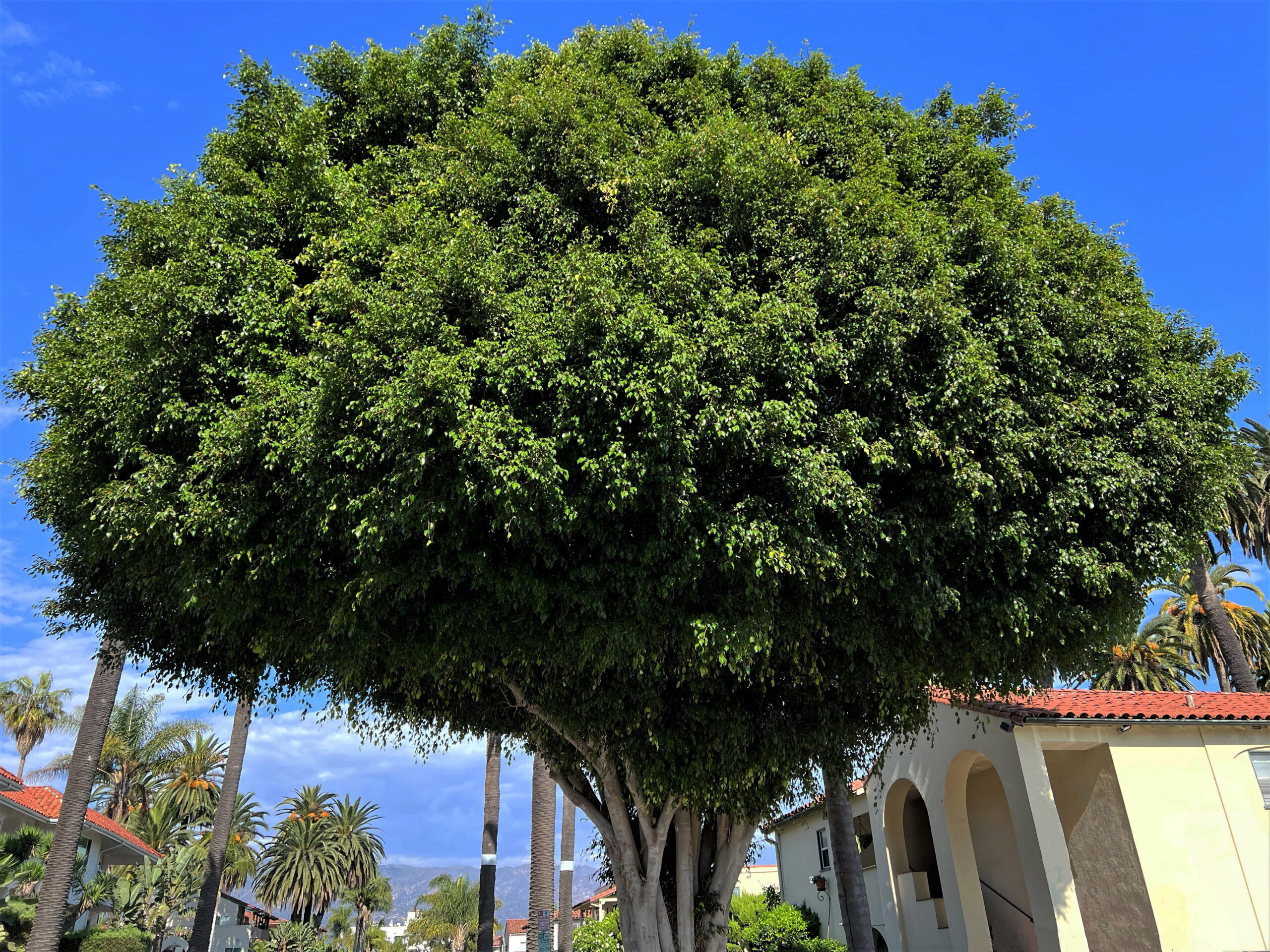Santa Barbara Beautiful Tree of the Month – November 2022

Ficus benjamina
While known primarily as an elegant indoor foliage plant, in our Mediterranean climate the Weeping Fig matures into a stately, medium-sized, broadleaf evergreen landscape tree. Undoubtedly, many of the Weeping Figs around town were first grown inside as house plants – outgrew their pots and spaces – and were subsequently planted outside.
In our area, the Weeping Fig normally reaches 25- to 30-feet in height and carries a rounded dense crown that spreads to 30-feet in width, providing generous shade. Under ideal conditions, it can grow even larger, so be careful where you plant it!
The limbs and branches grow upright but arch downwards at the ends, creating a graceful weeping effect. While it is normally a single-trunked tree, it frequently has lower branches that develop into multiple trunks; subsequently, these can self-graft into a single trunk. Young trees can also be pruned to have a single trunk.
Perhaps the Weeping Fig’s most distinguishing characteristic is its shiny green leaves. These are ovate-elliptical shaped (4-inches long and 1½-inches wide) and appear alternately on the twigs. Each leaf has a pronounced end pointed (acuminate) tip that is often bent backward and twisted, making it easy to identify this tree from other Ficus species.
The Weeping Fig is monoecious, meaning each tree bears both female flowers and male flowers. The flowers develop and remain entirely sheltered on the inside of a fleshy, hollow, receptacle called a syconium. On all fig trees, this type of flower-bearing structure (inflorescence) is also the fruit. The encased flowers are pollinated by tiny wasps that enter the syconium’s tiny hole at its terminal end. Once the flowers are pollinated, the resulting spherical fruits (1/3- to ½-inch in diameter) usually occur in pairs, are green when young, and turn orange-red when ripe. The fig fruit is technically edible; however, it is usually only eaten by birds.
Its bark is light-gray and relatively smooth when young; this surface changes to raised horizontal lenticels as the tree matures. At any age, the bark is quite striking in contrast to the glossy foliage and accentuates the often deeply contoured and sculptural trunk and limbs.
The Weeping Fig is native to a wide area extending from the tropical areas of eastern India, Southeast Asia, Indonesia, and northern Australia. In all areas where it is endemic, it is highly valued and appreciated for its dense shade, for firewood, and for many medicinal uses. In Thailand, it is so revered for its beauty that it has been designated the official tree of Bangkok.
In addition to the common name of Weeping Fig, this lovely tree has many other common names, including Benjamin Fig, Java Fig, Weeping Chinese Banyan, Weeping Laurel, Java Laurel, and Small-Leaved Rubber Tree.
Weeping Fig is in the Moraceae or Mulberry plant family, which includes all figs trees, including the species, Ficus carica, that bears the delicious edible figs found in markets around the world. Weeping Fig’s botanical name is Ficus benjamina. The genus, Ficus, is the Latin name for the edible fig. The specific epithet, benjamina, is derived from the Sanskrit word, “banij”, meaning “banyan tree” (which is also in the fig family).
Mature Weeping Figs are often confused with Indian Laurel Figs (Ficus microcarpa, var. nitida), since they have a similar crown shape and identical bark and leaf color; the Weeping Fig’s twisted pointed leaf tips distinguish it from its cousin.
Weeping Fig, although a tropical tree, is easy to grow in our Central Coast area and, once established, appears to be surprisingly drought tolerant. It does appreciate some deep watering in the dry season and during extended droughts. It is not cold hardy, so it does need to be placed in a frost-free or protected location; otherwise, when temperatures dip below 30 degrees F, it can experience significant leaf and twig damage and dieback. It prefers well-drained, moist, loamy soil and full sun to partial shade.
There are numerous cultivars of Weeping Fig that have been developed in the nursery trade for use as indoor foliage plants, because of this tree’s ability to photosynthesize at low light levels. Such cultivars have been selected for their variations in leaf color and/or for white or yellow variegation. Most of these lovely cultivars can also be used in our community as home garden trees, either planted in the ground or potted in containers. The cultivar ‘Starlight’ has earned the coveted Royal Horticultural Society’s Award of Garden Merit. Miniature cultivars, such as ‘Too Little’, are especially popular with bonsai enthusiasts.
Weeping Fig is not susceptible to serious insect or disease pests but is prone to some bothersome (but not life-threatening) insects, like Cuban laurel thrips (which curl the leaves) and stem scale (which sucks the sap and deposits a sticky substance that creates sooty mold).
Fair Warning: As with most species in the genus Ficus, Weeping Fig will develop aggressive surface roots, which can be destructive to nearby structures and to hardscapes, particularly sidewalks. Always plant it in a location that provides sufficient space to accommodate its roots at maturity. When planted in smaller spaces, it is advisable to prune it periodically to keep it in scale with the planting area and to limit root expansion.
The Weeping Fig can be planted and then regularly pruned, for use as a screen or hedge. However, it is best suited for planting in city parks and on large estates, where it will be given the space needed for its full beauty and grandeur to be appreciated.
Weeping Figs can be seen in many locations about town: in Alice Keck Park Memorial Garden; east of the Los Banos Pool on West Cabrillo Boulevard (7 trees); in the 200 Block of West Mason Street (7 trees); at the southeast corner of West Padre and Castillo Streets (4 trees); in the first block of Bath Street (3 trees); at 622 Bath Street (2 trees); at 402 De La Vina Street; and, at 21 S. Alisos Street.
Tree-of-the-Month articles are sponsored by Santa Barbara Beautiful, whose many missions include the increase of public awareness and appreciation of Santa Barbara’s many outstanding trees and, in a long-time partnership with the City Parks & Recreation Department, the funding and planting of trees along the City’s streets.
Those who wish to honor a special someone can do so with an attractive commemorative marker that will be installed at the base of an existing street tree in the City of Santa Barbara. Because Santa Barbara Beautiful has participated in the planting to date of over 13,000 street trees, there are plenty of trees from which to choose! Application forms are available on the Santa Barbara Beautiful website, www.sbbeautiful.org.
Article and photos by David Gress


